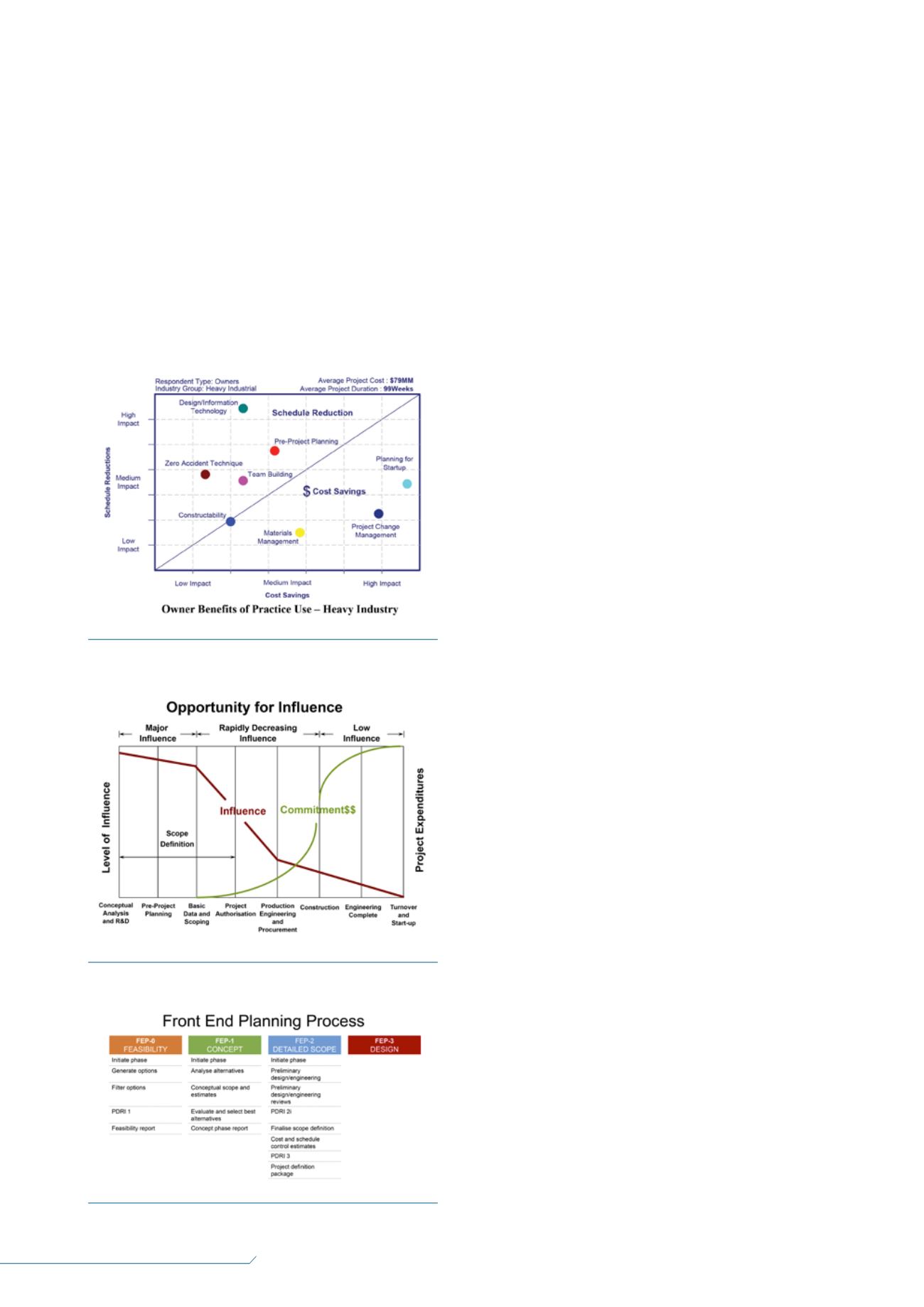
34
LNG
INDUSTRY
SEPTEMBER
2016
Developers have vast and diverse value interests that include
cost, schedule, quality, reliability, life span, constructability,
maintainability, etc.
1
Understanding and streamlining a process
that addresses these value interests and can be rapidly executed
is critical. The speed to market can mean more lucrative pricing
and terms with offtakers and end users.
It all begins and ends with planning. In fact, pre-project
planning has been shown to have the single largest impact on
cost and schedule savings on all industry groups (Figure 1). The
ability to influence a project (configuration, schedule, etc.) is
dramatically decreased while expenditures rapidly increase as a
project progresses. The optimum time to influence the final
project at the lowest cost is during pre-project planning
(Figure 2). A formalised and successful planning approach is the
front end planning (FEP) process, developed by the Construction
Industry Institute and discussed in its publication, RS213-1.
2
This
FEP gate process is shown in Figure 3 and consists of four
phases.
FEP-0: feasibility
The first action a developer takes toward deciding whether or
not to pursue a project is to determine its feasibility or return on
investment (ROI) – the likelihood of operating the facility at a
profit. To calculate ROI, developers rely on either sophisticated
internal models or external consultants. ROI variables include
capital cost, operating costs and time to market. In FEP-0,
parametric information is typically used. If the models yield a
positive outcome, the project is pursued. FEP-0 components
include the following:
Identification of potential technologies and technology
providers.
Determination of a potential region or location with a
significant unmet demand for LNG. This demand could be
for marine bunkering; rail fuelling; remote location, high
horsepower (HHP) equipment; or a combination thereof.
Market research includes a review of historical purchases of
diesel and heavy fuel oils (HFO), discussions with potential
users and business intelligence regarding competitors.
Establishment of initial project economics. Project
economics are tied to both estimated total LNG demand
from all potential users in the target region and the current
LNGmarket cost. The initial economics models drive
the project capital and operating costs and establish the
profitability.
Review of the federal, state and local regulations that are
applicable and determination of the jurisdiction responsible
for regulatory enforcement for the facility. Additionally,
assessment of the community view of the risks and rewards
of a future LNG facility is performed.
Identification of a suitable site for the facility. Although
the firm required footprint may be unknown, the general
space can be estimated based on similar capacity facilities.
Considerations should include additional regulatory buffer
or exclusion zones between the new facility and existing
neighbours.
If a potential parcel is available and the acquisition costs are
known, the project economic evaluation can be updated
to determine if the projected costs and revenue are still
consistent with a favourable ROI.
If a site is identified, the developer can also have a
geotechnical consultant performminimum on-site sampling
and testing to define soil properties and recommend
foundations. As an alternate, existing geotechnical data
within the vicinity can be used. This information can facilitate
preliminary designs and cost estimates in FEP-1.
Before moving on to FEP-1 (concept) and FEP-2 (detailed
scope), the developer should also decide on the contracting
approach.
In a conventional contracting approach, FEP-1 and FEP-2
studies are performed by a consultant selected by the developer
based upon reputation and expertise. At the end of FEP-2, a
detailed performance specification and scope of work is
prepared by the consultant and bids solicited from technology,
Figure 3.
Front end planning (FEP) processes.
Figure 2.
Project lifecycle: opportunity for influence.
4
Figure 1.
Owner benefits from practices used in the
construction industry.
3


